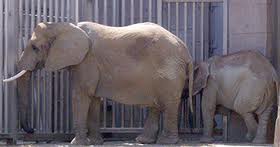At the Munich Zoo you can watch the courtship rituals of the banded mongoose, hear the morning song of the scarlet ibis or visit the Indian elephants, who help help keep the lights on with electricity generated from their dung.

It works like this: The zoo has built three large containers, each capable of holding about 100 cubic meters of animal waste — that’s around a week’s worth of dung collected from all the vegetarian animals in the zoo.
Once inside the containers, it’s mixed with warm water and the bacteria in the dung is left to decompose in an oxygen-free environment for 30 days.
The resulting biogas, mainly comprised of methane and carbon dioxide, rises naturally through vents in the ceiling to a corrugated hut on the roof where it’s collected in a “big balloon,” says park supervisor Dominik Forster.
The biogas is then fed into a gas-powered engine that’s used to generate electricity. Forster says that the balloon — which more closely resembles a small Zeppelin — can store enough biogas to meet 5% of the zoo’s energy needs.
Dr Geraint Evans, National Centre for Biorenewable Energy “When you turn the biogas into electricity, it creates heat which we also store,” says Forster. This is then used to warm the gorilla enclosure, “but could be used to heat about 25 homes,” he adds.
Once the fermentation process that creates the methane is finished, the remaining solid matter, or “digestate” is used as an organic fertilizer for crops that will later be used as feedstock for the animals.
“We don’t waste anything,” said Forster, who claims that his is the only zoo in Germany to generate electricity in this way.
A mature elephant can eat about 100 kilograms of fruit, vegetables and pretzels a day, producing a mountain of dung and Forster says that all the zoo animals together create roughly 2,000 tons of the stuff every year.

